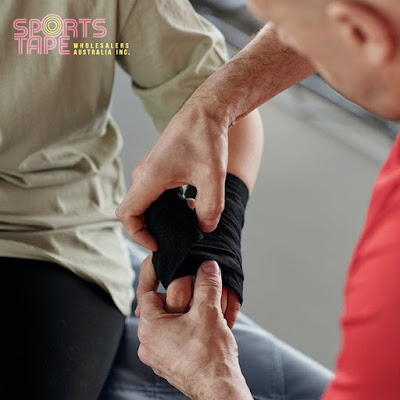The study of body mechanics is known as Kinesiology and that’s why Kinesio tape is many times known for providing relief to muscle movement. This tape is quite thin and flexible and is meant to reduce swelling, pain, and inflammation along with extending support to muscles as well as joints.
Originally, K-tape was developed as a method to improve the performance of athletes. However, in the event of swelling, this sports tape Australia functions to ascent the skin thus expanding the space under the skin along with restoring normal circulation of the lymphatic fluid. Mentioned below are the injuries that get cured by the application of kinesiology tape:
1. Knee pain: This happens to be one of the most typical issues by runners, as it happens because of weak glutes. It is advised to take 2 strips over the quad muscle and then drop them down the left and right end of the knee cap in order to form a shape of a teardrop. Next, a strip must be placed in a way that it runs across the other two knee caps.
2. Low back pain: Two strips of K-tape must be cut into equal length followed by placing the strip just above the pelvis to the surface of the spine in coordination with the muscle. The muscle fibers must be stretched up to 75% at back. Another strip must be placed without any stretch along with repetition on the opposite side of the lower back.
3.
Plantar Fasciitis: This injury takes place when the connective tissue from the heel to the base of the toe gets overloaded. One strip of the
sports strapping tape must be used at the bottom of the foot and another strip must cross the first on the cove area at the bottom of the foot.
4. Achilles Tendon Pain: Extensive stress can stretch and overwork the tendon that joins two important calf muscles towards the back of the bone in the heel. One strip must be taped at the beginning of the mid-calf down the bottom of the foot followed by another strip that crosses over the back of the ankle.
5. Shin Splints: This injury happens when the front muscles of the shin get overloaded resulting in inflammation of the tendon, muscle, and bone. Taping must be done from the below of the knee to just under the base of the toe followed by taping of additional strips to the length of the shin over the pain points.
To sum up, if the player has some injury that results in extensive swelling, pain, or loss of motion; then their physio may suggest them to use sports strapping kinesiology tape so it may help in treating their problem.
It’s the responsibility of the physiotherapist to teach the player about different tapes and help them is fixing realistic expectations and goals in regard to the application of kinesiology tape.




Comments
Post a Comment